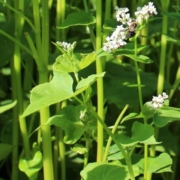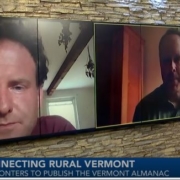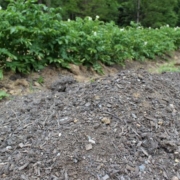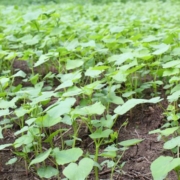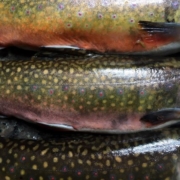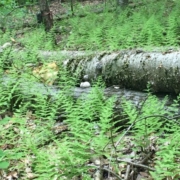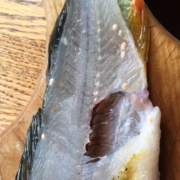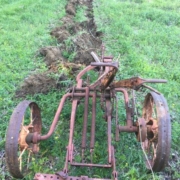Abuzz
The pleasure of my summer has been watching the food plot I planted in May come along . . . has been watching the wildlife garden I planted in May come along . . . has been watching the . . .
It’s hard to come up with the right descriptor.
I broke ground in May for a wildlife garden in the back-backyard, up against the tree line. The problem with calling it a wildlife garden is that it sounds so Ranger Rick. As the proud father of a three-year-old, I’m nevertheless trying to hold on to a bit of my adult self. It is a food plot, but I’m uncomfortable with that blunt, clinical phrase in the other direction, especially with the implication that its sole purpose is to hang a tree stand over. To be clear I’m not above meat-hunting, and if a fat doe presents a legal opportunity this fall while availing herself of the forage, there’s a chance she’ll end up in the freezer. But the goal here is a lot bigger than hunting. It’s about giving back, to deer but also to every other animal that wants to avail itself of the planting.
The original plan was a buckwheat crop that I’d knock over right about now, to be followed by a fall clover planting. In theory, I want to kill the buckwheat before it goes to seed. But in practice, I just can’t bring myself to do it. When I envisioned helping animals I was picturing mammals, but this planting is so abuzz with thousands of insects that I’ll likely miss my window.
In the quiet morning you can hear the buzz emanating from the quarter-acre plot at about 50 feet off. I spent some time this morning standing in the chest-high flowers, just feeling the pulse. There were hundreds if not thousands of honey bees, and bumble bees of all different species, but most remarkable were the pollinators I’d never taken the time to observe. Little yellow jacket mimics that hovered like hummingbirds. Jewel-colored flies and wasps of all sizes. Black insects with orange bottoms and soft, moth-like wings. Dainty wasps with hornet-butts and delicate, French-looking wings. Aggressive-looking horsefly-sized flies. Nondescript flies. Ants of every size and shape. Tiny butterflies that you could spend a morning trying to ID.
I remember interviewing an entomologist for a story years ago, who told me that while there were something-thousand known insects in the Northeast, there are likely thousands more that have yet to be classified. There’s a chance that some of the pollinators I was watching have never been documented. And with the well-known struggles pollinators are having these days, there’s a chance some could go extinct without ever being “known.”
And so the buckwheat stands, and the clover planting is being pushed off until the buzz dies down.
Vermont Almanac on WCAX
Dave Mance and Patrick White appeared on WCAX on July 13 to talk about Vermont Almanac. Our thanks to host Céline McArthur–the conversation was a great opportunity to introduce our new annual book about life in rural Vermont to an audience around the state. Here’s a link in case you missed it, here’s a link to the WCAX segment.
Taking Responsibility
Wendell Berry once pointed out that if we believe that the ultimate reality is political, and therefore the ultimate solutions are political, we’re going to have a hard time doing right by the land.
I’ve been thinking of this as Vermont unrolls its new mandatory composting regulations. As of July 1, residents are required to keep vegetable waste out of the trash, though in reality ANR will not be searching garbage bags for compliance. If these composting regulations are to lead to a greater good, people will have to buy in and change their habits. The private sector will need to figure out how to absorb or pass on the extra costs. Homeowners will have to figure out how to discourage or live with more crows and skunks and coons and bears. Farmers are going to have to figure out how to incorporate finished compost in lieu of synthetic fertilizer, even though it’s more expensive and harder to handle. If people are going to be motivated to do this, they’ll need to see the earth as something more than dead matter upon which they drive to and from work.
Berry’s point is that when we see things through a political lens, it’s easy to sub out the hard work to others and then Monday-morning-quarterback the results. Politics – especially these days – also turns simple things into complicated, existential things. The relatively straightforward issue of not throwing a banana peel in the garbage can become an affront to our personal liberty and right to make a living, or a dramatic first step towards a worldwide eco-revolution. The reality is that the politics here are a nudge, trying to push society in a less wasteful direction.
If we’re to do the enormous work of learning to live within our means on an increasingly fragile planet, we need to start with simple steps that are manageable and that we can each be responsible for. For those of us who live in rural areas – which geographically speaking is the majority of us – we now have to scrape our food scraps into a bowl and walk it to the hedgerow each night. I can handle that.
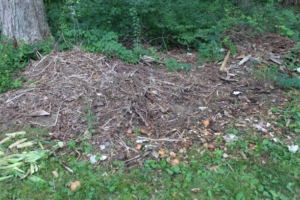
Composting can be as simple or as complicated as you want to make it. Here’s the years-old compost pile in my hedgerow. We compost everything, including meat scraps. It doesn’t smell unless you’re standing on top of it. We ignore the crows and opossums. We delight in visits by foxes and bears. We’re not trying to make a finished product.
A Buckwheat Planting for Soil Health
The people who founded this publication all come from the forestry world, a craft that’s a lovely mix of art and science and voodoo. One of the things that fascinates me about it is the lack of control. You never start with a blank canvas – even clearcuts have unpredictable seed banks – and so you’re managing a forest that has its own ideas about what and how it wants to grow. You’re also working on crazy timescales: 10 years, 30 years, 70 years, 100 years until you see the results of your inputs. The best foresters I know practice the craft like the best teachers I know. They evaluate, then meet the trees/pupils where they are. They help the site reach its maximum potential, which in different scenarios means different things. They balance economic productivity with wildlife habitat goals and ecosystem health.
This is all so different than traditional agriculture, where your goal is to grow a crop. Sure, you’re still worrying about ecosystem health, albeit in different ways. But where it comes to the ground you’re cultivating, you buy seed that’s already been selected for overachievers, you create as blank a canvas as you can each spring, and then you grow towards a goal of maximum yield. The whole endeavor ends within the span of a growing season.
These differences between Ag and Forestry feel both foreign and exhilarating to me. And I guess the part that appeals to me most is the ability to build and strengthen the soil, which is something you can only do very passively in the forest.
I’ve been working on the soil in two garden plots this year around my house, one for the family, one for the wild animals. The first step was to drag an old International Harvester two-bottom plow out of the hedgerow and use it to turn the earth. It’s 1930’s – 1940’s vintage, but it worked elegantly. This was followed by a pass with a set of disks of the same era, which did show some signs of their age. I ran into some snags in the garden plot – we’ll get to that in a different dispatch. But the food plot went better, and I was soon picking and piling clods. (Some are reading this and wondering why, if i’m interested in soil health, did i even plow at all? The simple answer to this fair question is that using a cool old piece of equipment with my three-year-old was more appealing than strapping on a backpack sprayer full of chemicals to kill sod. We’ll get into no-till systems in more depth in future content.)
When the field was prepped, I seeded it with buckwheat. The goal is to grow a crop for the soil, though crows and chipmunks (among other animals) love the seed, and it’s being munched by deer and cottontails as it grows, and it’s flowers will soon attract pollinators, especially honeybees. The plant’s roots loosen topsoil and the stems store phosphorous, which then gets released as it decomposes to be used by the next crop, which in this case will be a perennial clover mix.
Buckwheat is relatively easy to grow. Its big black seeds are highly visible and thus a breeze to broadcast. It’s not known to be particularly drought tolerant, but it weathered the drought we’re in like a champ. I used an old set of harrows to cover the seed. Knowing the implement was less than ideal, I overseeded to compensate. The charts call for 50 lb./ac; I probably seeded closer to 80 lb./ac. But seed’s cheap, so for a quarter-acre plot we’re talking maybe an extra $10 to overdo it.
You can see from the picture above that the results have been pretty good. Buckwheat grows fast, so in a few weeks from now it’ll flower, and a few weeks after that it’ll be ready to get turned in. If I were transplanting the next crop, I would cut and leave the buckwheat residue in the field to maintain soil stability and suppress weeds. But since I’m seeding, I’ll likely till it in. The downside to this is that I’ll be breaking up soil aggregates, the upside is that I’ll have a better surface for the clover to germinate in.
A real farmer across the road is rehabbing an old corn field with buckwheat this summer, too. Here’s a picture of his crop in as it breaks into flower. It smells 80 percent sweet and lovely and 20 percent dank and sour.
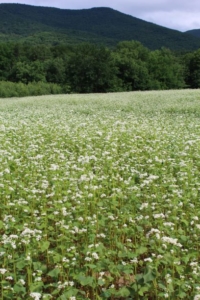
Trout Fishing in Vermont
Many outdoor pursuits, were they analogized to the written arts, would read like essays or newspaper columns. Trout fishing season on the other hand – all two hundred something days of it – is a full-fledged epic novel.
This pretend book – let’s call it “Trout Fishing in Vermont” – has a sprawling, Russian feel, heavy on symbolism and descriptive elements. The story unfolds somberly, the palette heavy towards blues and grays. There’s condensed breath against steely skies. Tension in roiling, potentially hypothermic whitewater. The landscapes are stark: rivers angry; lakes desolate and sterile seeming. First the lakes look glaucomic, with blue edges and icy pupils. Later they steam like cauldrons and appear hot to the touch.
The action is slow in the early chapters. Stocked rainbows provide simple sport and early-spring camaraderie, but the experience is often blunt. Native trout, which make you work for them, can be sluggish and disinterested at first. In fact, on cold years like this one, the book starts off at a glacial pace. But don’t worry. Stick with it, and “Trout Fishing in Vermont” will prove well worth your time.
When our protagonists do make more than a fleeting appearance, often in May, sometimes as late as June, it’s always breathtaking. Matriculated rainbows shine with sheen. Hook-jawed browns present pupil-sized crimson spots. Brookies – the loveliest of all – feature greenish vermiculations that give way to shades of cadmium yellow and pumpkin orange and salmon pink, vibrant colors that grow in depth through the seasons. Part of the charm is that all these fish are beautiful and shy. They’re also sensitive – especially the brookies. To find them, you have to seek out cold, clear water first.
As the novel progresses, it becomes bright and redemptive. Most of it unfolds at a quiet, arthouse pace. There are lots of wandering subplots. A whole chapter might be devoted to a doe and fawn drinking from a pool, or a river-bottom path that leads to a splatter of chanterelles. There are mid-day naps on shady sandbars, the remnants of a fish lunch nearby.
If this all seems random in my retelling, rest assured that the author somehow makes it work.
The human characters in the book are a ragtag bunch: absent-minded poet types, streamside entomologists, worm-can-toting youngsters with old souls, dandies with $1,000 fly rods, rebels with wild hair and empty wallets, to name a few. But while they come from all walks of life, they’re united in devotion to this one particular family of fish. Why not big cretin bass, or cast and catch panfish? Why not charter-boat blues? Why trout? You may as well be asking why love. Why sing.
Read the book and you’ll understand.
Ghost
I saw a small white mammal dash under a log a few weeks ago, and reflexively thought I’d seen an ermine. It was about a half mile up in the woods behind the house. It took a minute to dawn on me that it was summer, and ermines should be brown now.
I went back the next day and staked things out, and learned the animal was, in fact, an albino chipmunk. I also learned I was no nature photographer. The best I’ve been able to do so far was a poor cell phone picture and some flashes of game camera video. But it has been a good learning experience.
I was able to locate the burrow the white chipmunk was seeking refuge in, which seemed a good indication I was in the core area of its home range. It appeared to be young-of-the-year, based on its size. According to Mark Elbroch and Kurt Rinehart, in their book “Behavior of North American Mammals,” chipmunks are born blind and hairless in April or May, after a month-long gestation. But in just five weeks they emerge from their natal den and are ¾ of their adult size.
I set up a game camera and recorded thousands of videos over a seven day stretch. With the exception of false triggers, a gray squirrel who occasionally sauntered by, and oddly, a hummingbird, all the other daytime pictures – hundreds of them – were of chipmunks. But the white one appeared in only about a dozen of the photos, spaced semi-regularly over the whole seven day span. It just didn’t come out very much.
So why? It could simply be that it’s a young animal and not yet brazen enough to venture far. According to Elbroch and Rinehart, young of the year stick around the natal den for one to three weeks after first emerging, building courage, learning through play. There were several videos of a different young-of-the-year chipmunk chasing the white one, which seems to jive with this.
After the exploratory window, the mother bars the kids from the den and they disperse. Chipmunks are solitary animals, and with the exception of breeding seasons and the child-rearing window for mothers, they spend their lives alone.
Of course another theory as to why the white chipmunk doesn’t come out much is that its eyes are bad. People with albinism are considered legally blind. So if it is a true albino, and all the footage I’ve seen suggests it is, it likely has vision problems.
So how rare are albino animals? According to the National Organization of Albinism and Hypopigmentation, one in every 18,000 – 20,000 people in the U.S. has some type of albinism. A web search turned up an abstract from 1954 that estimated rates of albinism in gray squirrels in Maine at 1 in 10,000 – that’s the closest I could get to chipmunk. The Missouri Department of Fisheries documented a ratio of 1 in 20,000 in their stocked catfish inventory. We’ll never find an actual number, but safe to say it’s pretty rare.
Yellow Grub
Taking a three-year-old fishing is chock full of lessons. There are predictable ones: ichthyology, self-sufficiency, cause and effect. (“If you throw all the worms in the water, honey, we won’t have worms to fish with.”)
And then there are the random lessons you don’t expect to learn, let alone teach, like the ones involving the parasitic yellow grubs that you might find in perch meat. These animals have life cycles that, coolly enough, involve the blue herons that were flying over us while we fished, and the snails we were noticing on the bottom of the lake floor under the bridge we were fishing on.
So in the picture above you’ll see the cysts that were in the perch fillets. The grubs (Clinostomum marginatum) are inside. Humans aren’t part of the parasite’s lifecycle, and they die when you cook them, so the meat is still edible, if not exactly appetizing.
The parasite starts its life in an egg in a heron or a bittern’s throat. The egg is either regurgitated into the water as the bird feeds or shat out – reputable sources vary on that detail, which could be an indication that both things are possible. Once free of the bird, the egg hatches and the miracidia, as the little organism is called, finds a snail to infect. The parasite goes through several larval stages in the snail, then leaves the snail to find a fish. It infects a fish, then gets passed to a fish-eating bird when the fish is eaten. Once in the bird’s throat, the adult lays eggs and the lifecycle starts anew.
Back to the Earth
“We’re out of strawberry plants. And seed potatoes. And onion starts. We have a few asparagus left – that’s it. We’ve never sold out of everything this early in the 40 years I’ve been here.”
– elderly woman behind the counter of a feedstore in a small town
Reports from all over the region hold that there’s been a surge in gardening this spring, an idea that shines in the midst of a pandemic that’s killed 100,000 people in the past three months.
I’ve heard it explained in survivalist terms: people are afraid of food shortages so they’re taking matters into their own hands. I tend to see it more in spiritual terms. We shed our anxiety, or our grief, or our anger, by breaking ground. The world comes at us with waves of incomprehensible change, and so we look down to what moors us. We turn soil and turn inward towards something basic and primal and pure.
As World War I raged, more than a century ago, the poet Thomas Hardy wrote this poem called “The Breaking of Nations.”
Only a man harrowing clods
In a slow silent walk
With an old horse that stumbles and nods
Half asleep as they stalk.
Only thin smoke without flame
From the heaps of couch-grass;
Yet this will go onward the same
Though Dynasties pass.
Our crisis looks and feels different. Yet there’s still comfort in this rhythm.
Like the rest of you, I’m going all in on the garden this year. To make more space, I pulled an old drag plow out of the hedgerow and hooked it up to a tractor. I don’t know how old the plow is, but it’s old. There’s a chance Thomas Hardy was still alive when it was in use. The wheels skidded for a few meters but then turned. I walked it gingerly to an open area in the back, then popped the clutch rod. It landed with a thud, and as I pulled, two dark ribbons of earth unspooled in its wake.
It felt like prayer.

